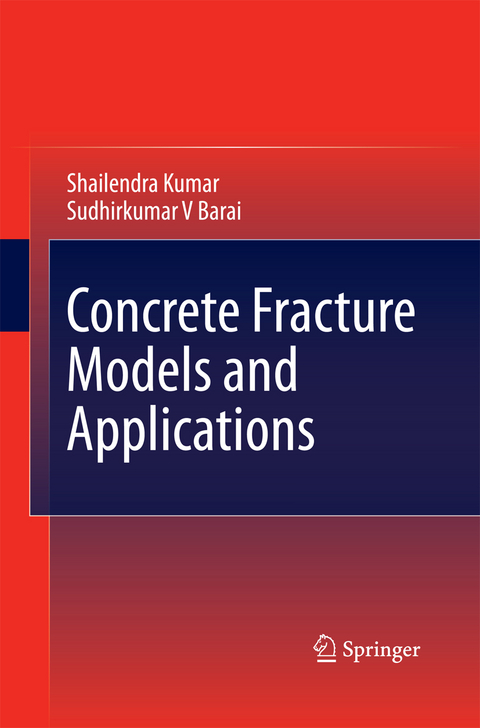
Concrete Fracture Models and Applications
Springer Berlin (Verlag)
978-3-642-42304-8 (ISBN)
Cementitious materials, rocks and fibre-reinforced composites commonly termed as quasibrittle, need a different fracture mechanics approach to model the crack propagation study because of the presence of significant size of fracture process zone ahead of the crack-tip. Recent studies show that concrete structures manifest three important stages in fracture process: crack initiation, stable crack propagation and unstable fracture or failure. Fracture Mechanics concept can better explain the above various stages including the concepts of ductility, size-effect, strain softening and post-cracking behavior of concrete and concrete structures.
The book presents a basic introduction on the various nonlinear concrete fracture models considering the respective fracture parameters. To this end, a thorough state-of-the-art review on various aspects of the material behavior and development of different concrete fracture models is presented. The development of cohesive crack model for standard test geometries using commonly used softening functions is shown and extensive studies on the behavior of cohesive crack fracture parameters are also carried out. The subsequent chapter contains the extensive study on the double-K and double-G fracture parameters in which some recent developments on the related fracture parameters are illustrated including introduction of weight function method to Double-K Fracture Model and formulization of size-effect behavior of the double-K fracture parameters. The application of weight function approach for determining of theKR-curve associated with cohesive stress distribution in the fracture process zone is also presented. Available test data are used to validate the new approach. Further, effect of specimen geometry, loading condition, size-effect and softening function on various fracture parameters is investigated. Towards the end, a comparative study between different fracture parameters obtained from various models is presented.
Shailendra Kumar is an Assistant Professor in the Department of Civil Engineering, National Institute of Technology, Jamshedpur, India. He received his B.Sc. (Engg) degree in Civil Engineering from NIT Jamshedpur, India in 1993, M.E. degree in Structural Engineering from NIT Rourkela, India in 1996 and Ph.D. degree in Structural Engineering from IIT Kharagpur, India in 2010. His research interests are Fracture Mechanics of Concrete, Fibre-reinforced Concrete and Soft Computing Applications. He has authored/co-authored more than 40 papers in International/National Journals and Conferences. Sudhirkumar V Barai is a Professor in the Department of Civil Engineering, Indian Institute of Technology, Kharagpur, India. In 1995, he obtained Ph.D (Eng.) from Indian Institute of Science, Bangalore, India. He received the degrees of B.E.(Civil) and M.E.(Civil) with specialization in Structural Engineering in 1987 and 1989, respectively, from the Faculty of Engineering, MS University of Baroda, Baroda, India. His research interests are: Structural Health Monitoring, Computational Mechanics and Concrete Technology. He has published more than 130 papers in leading international journals and conferences in his research fields.
Foreword.- Preface.- List of Symbols and Abbreviations.- Introduction to Fracture Mechanics of Concrete.- Fracture Mechanics of Concrete - State-of-the-Art Review.- Fracture Behavior of Concrete using Cohesive Crack and Size Effect Models.- Crack Propagation Study using Double-K and Double-G Fracture Parameters.- Fracture Properties of Concrete based on the KRcurve Associated with Cohesive Stress Distribution.- Comparison of Fracture Parameters of Concrete using Nonlinear Fracture Models.- Appendix. Subject index.
From the reviews:
"The book presents various nonlinear models of concrete fracture with definition of the corresponding fracture parameters. ... this comprehensive analysis of real behavior of concrete gives new findings in the systematization of results of different authors. The book will be useful not only to teachers and students concerning with the concrete fracture and related issues, but also to specialists incorporating the basic fracture principles into design standards." (I. A. Parinov, Zentralblatt MATH, Vol. 1215, 2011)| Erscheint lt. Verlag | 11.10.2014 |
|---|---|
| Zusatzinfo | XXII, 262 p. |
| Verlagsort | Berlin |
| Sprache | englisch |
| Maße | 155 x 235 mm |
| Gewicht | 438 g |
| Themenwelt | Mathematik / Informatik ► Mathematik ► Algebra |
| Naturwissenschaften ► Physik / Astronomie ► Mechanik | |
| Technik ► Bauwesen | |
| Technik ► Maschinenbau | |
| Schlagworte | Cohesive toughness • Size-effect • Softening function of concrete • Stress intensity factor • Weight function |
| ISBN-10 | 3-642-42304-3 / 3642423043 |
| ISBN-13 | 978-3-642-42304-8 / 9783642423048 |
| Zustand | Neuware |
| Haben Sie eine Frage zum Produkt? |
aus dem Bereich


